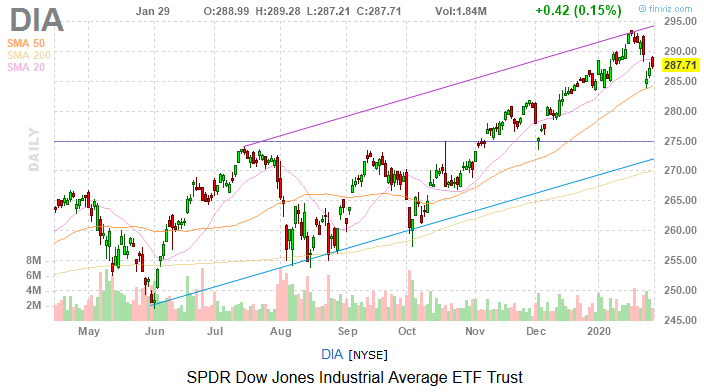On a day of 45 earnings reports, one profit update stood out and it was enough to support stocks on Wednesday.
- The S&P 500 fell 0.08%.
- The Dow Jones Industrial Average advanced 0.04%.
- The Nasdaq Composite increased by 0.05%.
- Apple (NASDAQ:AAPL) wasn’t the best-performing name in the Dow Jones today, but it turned in a stout performance and it was very much the reason why broader benchmarks closed higher.
Aside from earnings and the still spreading coronavirus, the other important headline today was courtesy of the Federal Reserve, which as expected, held interest rates steady. Unfortunately, the coronavirus situation is worsening in China, but as noted yesterday, U.S. investors appear to be shifting their focus to what’s happening with markets here and that means earnings.
Apple gave investors plenty of reasons to cheer today. The iPhone maker reported fiscal first-quarter earnings of $4.99 on revenue of $91.82 billion, trouncing Wall Street’s estimates of $4.55 per share and revenue of $88.50 billion. However, earnings are in the past, but Apple obliged eager market participants with a stellar sales forecast for the current quarter, projecting $63 billion to $67 billion in sales, well ahead of the consensus estimate of $62.45 billion.
Apple also spent $20 billion buying back its stock last quarter, at elevated prices, but the company’s cash hoard grew by $1 billion to $99 billion.
And if you want more good news, 75% of the Apple Watch buyers last quarter were first-time customers of the company.
Speaking of Good News
Dow Chemical (NYSE:DOW), the lone materials name in the blue-chip index, is finally delivering some good news as it, not Apple, was the benchmark’s best-performing name on Wednesday with a gain of 5.3%.
Dow said it earned 78 cents per share in the fourth quarter on sales of $10.2 billion. Analysts were expecting earnings of 74 cents on revenue of $10.07 billion. The company forecast first-quarter sales of $10 billion to $10.4 billion, below estimates of $10.76 billion. However, the stock surged on a forecast of $130 million in cost savings this year after $35 million in cuts last quarter.
Bad News Baked Into Boeing?
Boeing (NYSE:BA) was in the mix as one of the best Dow performers today, jumping 2.30% despite a fourth-quarter earnings report that was as bad as expected. “As expected” may be the operative phrase there because Boeing has been a consistent bearer of bad news in recent months, indicating that plenty of negativity is already baked into the stock.
In the December quarter, Boeing lost $2.33 per share on revenue of $17.91 billion. Wall Street was expecting a loss of $1.47 on sales of $21.67 billion. The company also lost money on an annual basis in 2019, marking the first time in 20 years that has happened.
Boeing did update investors on the production schedule for the 737 Max passenger plane, saying it plans to produce 10 of those jets per month starting next year before ramping up to 12 a month in 2023.
“We are focused on returning the 737 MAX to service safely and restoring the long-standing trust that the Boeing brand represents with the flying public…fortunately, the strength of our overall Boeing portfolio of businesses provides the financial liquidity to follow a thorough and disciplined recovery process.,” said CEO David Calhoun.
After The Close
The earnings parade moves forward today after the market closes with several big-name technology and communication services names reporting, including Microsoft (NASDAQ:MSFT).
Inevitably, there will be some Apple comparisons because Microsoft is the other member of the $1 trillion club. And like Apple, if Microsoft can beat its guide for the quarter, its stock is poised to rally regardless of its enormous market value.
Expect comments on cloud unit Azure and, to a less extent, Office 365, to be in focus when Microsoft reports later today.
Bottom Line on the Dow Jones Today
With earnings season in full bloom, it’s worth noting that it would be helpful profits to increase because the price-to-earnings ratio on the S&P 500 is trending higher.
“The forward 12-month P/E ratio of 18.7 on January 17 was above the four most recent historical averages for the S&P 500: 5-year (16.7), 10-year (14.9), 15-year (14.5), and 20-year (15.5),” notes FactSet. “In fact, this marked the first time the forward 12-month P/E had been equal to (or above) 18.7 since May 28, 2002 (also 18.7). However, it is important to note that even at 18.7, the forward 12-month P/E ratio was still well below the peak P/E ratio (of the past 20 years) of 24.4 recorded on March 24, 2000.”
As of this writing, Todd Shriber did not own any of the aforementioned securities.
